Tremarctos floridanus
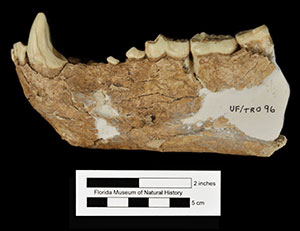
Quick Facts
Common Name: Florida spectacled bear
Much more common as a fossil in Florida than the living black bear.
Thought to be primarily a herbivore like the living South American spectacled bear.
Sometimes called the “Florida cave bear” but they are not closely related to the European cave bear, nor is there fossil evidence of a dependence on caves for denning.
Age Range
- In Florida, this species is restricted to the Rancholabrean North American land mammal age (late Pleistocene Epoch). There are a few published records of Tremarctos floridanus from the Irvingtonian and Blancan NALMAs (early Pleistocene epoch) in Western North America, but their species level classification needs confirmation.
- About 250,000 to 11,000 years ago in Florida, but possibly up to 2 million years ago in western North America.
Scientific Name and Classification
Tremarctos floridanus Gidley, 1928
Source of Species Name: The species name refers to Florida, where the first described specimen of the species was found (Gidley, 1928).
Classification: Mammalia, Eutheria, Carnivora, Caniformia, Arctoidea, Ursida, Ursoidea, Ursidae, Tremarctinae
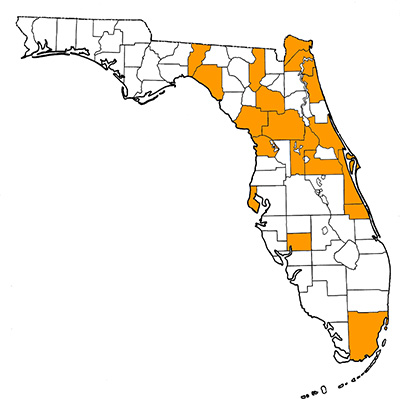
Alternate Scientific Names: Arctodus floridanus; Tremarctos mexicanus
Overall Geographic Range
Fossils of this species have also been recorded in several localities in southern North America along the Gulf Coast, New Mexico, Mexico, Tennessee, and Georgia (Guilday and Irving, 1967; Kurtén and Anderson, 1980). The type locality is the Golf Course locality in Melbourne, Florida (Gidley, 1928).
Florida Fossil Occurrences
Florida fossil sites with Tremarctos floridanus:
Discussion
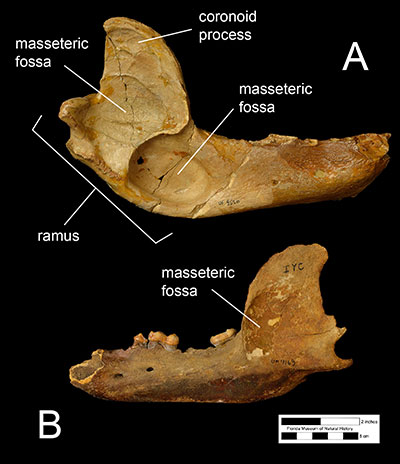
Ursidae is the mammalian family that includes all living and fossil bears. Tremarctos floridanus, or the Florida spectacled bear, is an extinct member of the ursid subfamily Tremarctinae. Tremarctine bears are a North and South American group thought to have descended from bears that entered North America from Asia around the Miocene-Pliocene boundary, probably from the Old World bear genus Ursavus (Figueirido and Soibelzon, 2009). Tremarctos floridanus is believed to be closely related to the Andean spectacled bear (Tremarctos ornatus), the only surviving species in the Tremarctinae.
Members of the Tremarctinae are differentiated from members of the Ursinae, a major subfamily of bears that comprises of most other extant bears, by the double masseteric fossa on their mandibles (Figure 2A) and by a characteristic accesory cusp on the buccal (cheek-facing) side between the trigonid and talonid basins of the lower first molar (Figure 3A; Kurtén and Anderson, 1980). In general, tremarctine bears also have shorter, taller skulls, larger, rounder, and more laterally oriented orbits, and well-defined zygomatic arches (Figueirido and Soibelzon, 2009). Ursine bears, on the other hand, have only one masseteric fossa (Figure 2B) on their mandible and more slender, elongated skulls with generally narrower molars (with the exception of the polar bear, Ursus maritimus). The genus Tremarctos is differentiated from other tremarctine bears by the presence of relatively smaller teeth, retention of the anterior premolars (Figure 4), well-defined masseteric fossae, and a W-shaped cusp pattern on the lower first molar (Figure 3B; Kurtén and Anderson, 1980).
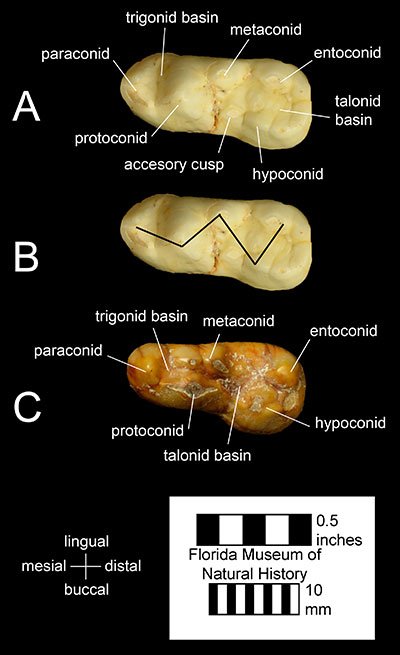
Numerous fossils of Tremarctos floridanus are known from Florida. The holotype of this species consists of a partial skull and jaws from Melbourne, Florida (which can be viewed here). The species was initially placed in the genus Arctodus by Gidley (1928), but was later reclassified into the genus Tremarctos by Stock (1950), who also described and named a new species, Tremarctos mexicanus, which was later synonymized with Tremarctos floridanus by Kurtén (1966). The postcranial biology of Tremarctos floridanus is well known from several skeletons discovered in the Devil’s Den locality in Levy County, Florida (Kurtén, 1966), as well as from a skeleton from Grassy Cove Saltpeter Cave, Cumberland County, Tennessee (Guilday and Irving, 1967).
Overall, the anatomy of Tremarctos floridanus is similar to that of Tremarctos ornatus, although the fossil species is about twice as large as the extant spectacled bear. As such, Tremarctos floridanus was probably about as big as a larger American black bear, Ursus americanus (Guilday and Irving, 1967). However, like other bear species, Tremarctos floridanus was sexually dimorphic (Figure 5A-B); males of the species were approximately 25% larger than the females (Kurtén, 1966). However, Tremarctos floridanus was not simply a scaled up version of Tremarctos ornatus; postcranial proportions differed as well. The limb bones (especially the humerus and femur) and the neck of Tremarctos floridanus are relatively longer compared to body length than in Tremarctos ornatus, making the extinct spectacled bear a relatively long-limbed species. However, the paws are relatively shorter and smaller for its body size than those of the Andean spectacled bear. In addition, while most other bears have longer hindlimbs than forelimbs, the hindlimbs of Tremarctos floridanus are around the same length as their fore limbs (Kurtén, 1966).
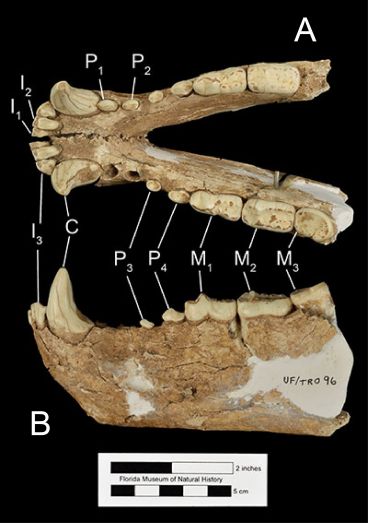
Cranially, the teeth of Tremarctos floridanus posterior to the canine are anatomically very similar to those of Tremarctos ornatus, the Andean spectacled bear, save their larger size and some proportional differences (Kurtén, 1966). The number of premolars may be reduced in Tremarctos floridanus relative to Tremarctos ornatus, however, and the posterior molars are relatively longer (Kurtén and Anderson, 1980). Like Tremarctos ornatus, Tremarctos floridanus has a short rostrum compared to ursine bears, but is relatively narrow compared Tremarctos ornatus. The frontal bone of the cranium of Tremarctos floridanus also has a characteristic “glabella”, or dome-like protrusion, that is not present in Tremarctos ornatus (Kurtén, 1966). The lower jaws of the two species are also anatomically similar although the fossil form is larger. The ramus of the mandible is taller in the extinct spectacled bear compared to that of the Andean spectacled bear but the relative height of their coronoid processes are about the same.
Fossils of Tremarctos floridanus are sometimes found with those of the extant American black bear, Ursus americanus (Kurtén and Anderson 1980). While aforementioned differences between the skulls and dentition of tremarctine and ursine bears are helpful in identifying these similarly-sized species, the North American spectacled bear can be distinguished from fossil North American black bears by several postcranial features. Like other tremarctine bears, the humerus of Tremarctos floridanus has an entepicondylar foramen, while that of Ursus americanus does not (Figure 5). The proximal end of the radius of Tremarctos floridanus is oval-shaped, but is more triangle-shaped in Ursus americanus (Figure 6). The pelvis of Tremarctos floridanus may be distinguished from that of Ursus americanus by the narrower ischial bar and ridge of the bone around the acetabulum. The femur of Tremarctos floridanus has a taller (more superiorly protruding) greater trochanter than that of Ursus americanus. Axially, anatomy and proportions of the cervical vertebrae differ, and the North American black bear has 14 sets of ribs, while the North American spectacled bear has 13 (Kurtén 1966).
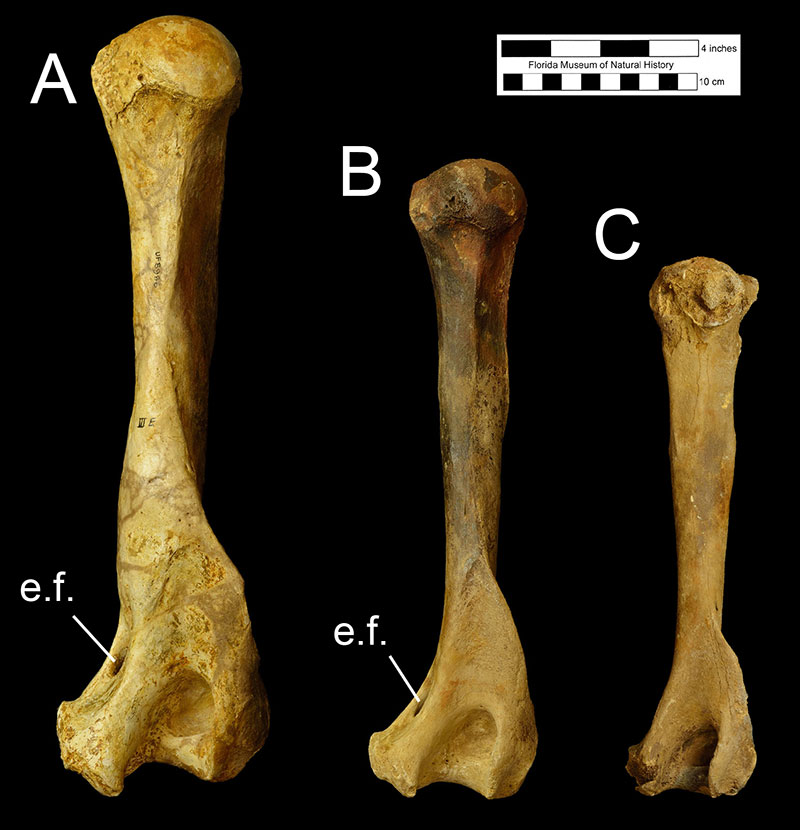
Because they may be found in the same fossil localities, it is likely that Tremarctos floridanus and Ursus americanus had dissimilar ecologies which allowed them to coexist.
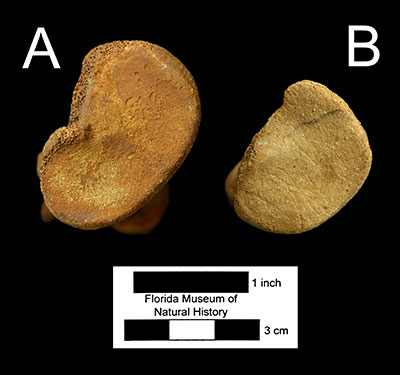
One hypothesis is that the diet of Tremarctos floridanus and Ursus americanus could have been the factor differentiating their niches (Kurtén and Anderson, 1980). Ursus americanus is an omnivorous species, while Tremarctos floridanus has been hypothesized to have been an herbivorous bear like its closest living relative, Tremarctos ornatus. Herbivory in Tremarctos floridanus is supported by cranial, mandibular, and dental similarities between the extant Andean spectacled bear and the extinct North American spectacled bear, which show many specializations for an herbivorous diet compared to other bears (Kurtén, 1966). A recent morphometric analysis of the shape of the cranium and mandible of tremarctine bears has also lent support to this hypothesis (Figueirido and Soibelzon, 2009).
Sources
- Original Author: Arianna Harrington
- Original Completion Date: March 30, 2015
- Editors’ Names: Arianna Harrington, Richard C. Hulbert, Jr., and Natali Valdes
- Last Updated On: April 10, 2015
This material is based upon work supported by the National Science Foundation under Grant Number CSBR 1203222, Jonathan Bloch, Principal Investigator. Any opinions, findings, and conclusions or recommendations expressed in this material are those of the author(s) and do not necessarily reflect the views of the National Science Foundation.
Copyright © Florida Museum of Natural History, University of Florida